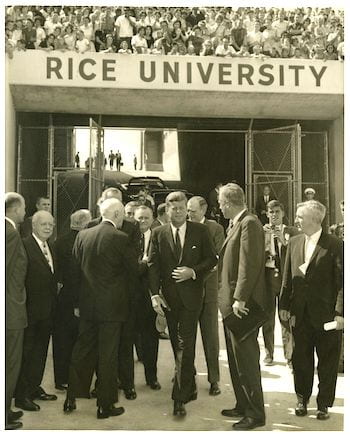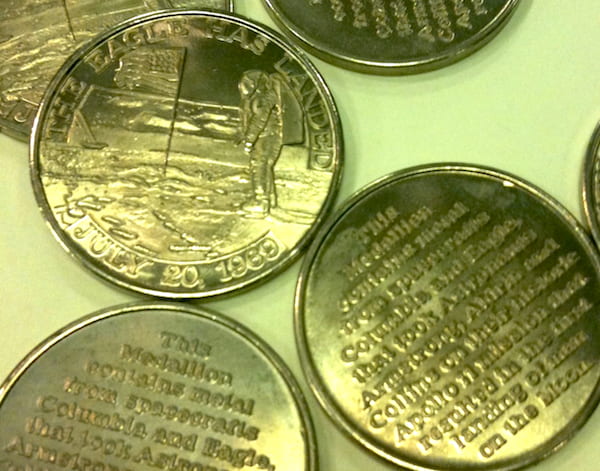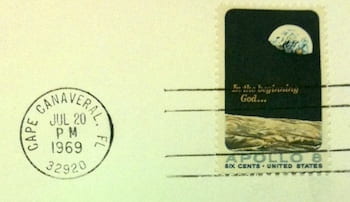2019 INTRODUCTION | PART 1 | PART 2 | PART 3 | PART 4 | PART 5 | PART 6 | LINKS
BY MIKE WILLIAMS AND JADE BOYD
Rice News staff
Americans will land on the moon again someday, perhaps as soon as 2024 if Artemis goes according to plan.
But there will never be another first, and Rice University and its people were there for the entire ride when astronauts established Tranquility Base on July 20, 1969.

President Kennedy and Rice President Kenneth Pitzer enter Rice Stadium on Sept. 12, 1962.
For the 40th anniversary of Apollo 11’s successful landing, Rice News presented a history of the university’s tight connection to NASA from the ’50s onward, exemplified best by President John F. Kennedy’s Rice Stadium speech to present his case for the moonshot to the public.
The lectern Kennedy used that day can be seen at Space Center Houston, but a replica on permanent display at Rice’s Fondren Library will be at Houston’s anniversary celebration at Discovery Green July 20 from 6-10 p.m. Visitors will have the opportunity to pose with JFK at the lectern.
You can click the linked pages to read our 2009 take on how Rice contributed to this distinctly American success story. Details of how Rice contributed to the Apollo program may also be found at nasa.rice.edu.
But we also want to bring you up to date on how Rice continues to support NASA as well as commercial space efforts as the nation prepares to return to the moon, this time to stay.
For starters, there’s a Rice alumnus, Jim Bridenstine ’98, running the show as NASA’s 13th administrator. The former Oklahoma congressman, who completed a triple major at Rice, visited campus earlier this year to dedicate a plaque at the Rice Stadium site of JFK’s inspiring speech and attend an Owls in Space Symposium that also featured astronaut Peggy Whitson ’85, who has more time in space than any American. She’s one of more than a dozen past and current astronauts with Rice connections, including Shannon Walker ’87, who earned three Rice degrees.
At Rice, former director of NASA’s Johnson Space Center George Abbey, who began working on Apollo in 1964, continues to write about the agency as a fellow at the Baker Institute for Public Policy, including his take on what it took to get to the moon the first time and an argument for returning as soon as possible.

A cache of commemorative Apollo 11 medallions from the Woodson Research Center archives of astronaut and professor Curt Michel. The medallions contained metal from the Columbia command module and the lunar lander.
Rice professor and historian Douglas Brinkley’s latest book, “American Moonshot,” analyzes the Apollo program and its social context, while the BBC came calling to record its Apollo 11 podcast series, “13 Minutes to the Moon,” at the Baker Institute in June.
The Rice Space Institute (RSI) maintains ties with NASA, its commercial partners and the Houston space community and fosters research that frequently involves Rice faculty and students. RSI Director David Alexander remains on the front lines, talking about how Rice and Houston will contribute to future activities in space and traveling with a city delegation to the international Paris Air Show to help make its case.
In recent years, Brown School of Engineering students at the Oshman Engineering Design Kitchen have designed a “lunar lounger” for future space outposts, enhancements to future robotic devices, microgravity devices to grow cell cultures, a rotor system for landing spacecraft and other projects.
Rice engineering students, working with computer scientist Lydia Kavraki, continue to refine programming for Robonaut, the robotic member of NASA’s International Space Station crew that is expected to play a major role in building and maintaining an eventual moon base.
Rice mechanical engineer Tayfun Tezduyar and his students have worked on fluid-structure interaction analysis of the landing and drogue parachute systems for the Orion spacecraft that will carry astronauts to the moon and back.

A cancelled stamp and postmark from the Curt Michel collection at Woodson mark the day of the first steps on the moon.
This year, Alexander partnered with bioengineer Tomasz Tkaczyk to develop a small, sophisticated spectrometer called TuLIPSS. The NASA-funded device may someday be mounted on a satellite or aircraft to instantly collect data across the visible and near-infrared spectrum to see things invisible to the naked eye.
RSI has also brought a steady stream of luminaries to Rice over the years for Houston Spaceport Lectures to talk about Apollo missions and their impact. Speakers have included Gene Kranz, flight director for Apollo 11 as well as Apollo 13; Apollo 12 moonwalker Alan Bean and Apollo 13 crew member Fred Haise.
Another recent lecturer, former Rice space science professor Brian O’Brien, continues to bang the drum for the results of moon dust experiments he designed while at Rice in the 1960s. O’Brien’s dust detectors flew on Apollo 11 through 15, and the data they produced then is helping Chinese space scientists interpret what they’re learning about dust affecting their Chang’e rover on the far side of the moon.
Finally, Rice Stadium was the site of a recent Apollo reunion for engineers and staff members who were part of the moon-landing team and astronauts from all eras. See NASA’s video and a behind-the-scenes video by Rice about the day here: https://news.rice.edu/2019/07/17/space-veterans-gather-to-honor-apollo-pioneers/



Leave a Reply